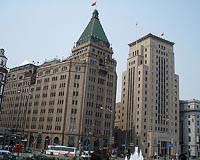 |
Jakarta (AFP) Feb 23, 2010 It has been the economic heartbeat of the world's fourth most populous country for almost 500 years, but Jakarta's days as Indonesia's capital could be numbered. Choked with traffic and garbage, the city on the northwest Java coast has been pushed to breaking point as its population surges above 12 million and its foundations sink under the weight of rampant development. Floods displace thousands of people and cause millions of dollars of damage every year, and are predicted to get worse with rising sea levels, unchecked logging in catchment areas and the blocking of canals with rubbish. A World Bank study has found that by 2025 the sea could be lapping at the gates of the presidential palace in the centre of the the former spice capital, known until 1942 as Batavia. This could explain why President Susilo Bambang Yudhoyono recently revived a radical plan to shift the capital to a new location. "Going forward, the idea of moving the centre of the administration must again be considered and developed, considering Jakarta has become exceedingly crowded," Yudhoyono told reporters in December. Similar proposals go back to previous presidents Sukarno and Suharto, who decades ago foresaw the eventual breakdown of Jakarta. "It can be done -- what you need is strong political commitment. Malaysia moved to Putrajaya because of the strength of Mahathir Mohamad," urban studies expert Deden Rukmana said, referring to Malaysia's ex-prime minister. "If we have a good plan ... we can build a city from scratch, like Brasilia in Brazil." Malaysia in 1999 began gradually shifting its administrative bodies to Putrajaya, 25 kilometres (15 miles) south of Kuala Lumpur, to reduce congestion and overcrowding in the capital. No one knows exactly how much the move cost in total, but more than 5.8 billion dollars was reportedly funded by taxpayers. Urban planners said the price tag on a new capital would be huge for Indonesia, but the cost of doing nothing would be higher. "Jakarta's problems can't be solved without expensive solutions," Rukmana said. "When the 2007 floods hit, you could see how much of an impact the city had on Indonesia. For days, Jakarta was dead and Indonesia's economy was crippled," Rukmana said. But where would Indonesia build its new capital? Jakarta is on Java, the most populous of Indonesia's 17,000 islands and home to its largest ethnic group, the Javanese, who are unlikely to relinquish their grip on the centre of national power. Military strongman Suharto favoured Jonggol, 50 kilometres east of Jakarta, but the idea was scrapped when he resigned in 1998. Indonesia's first president, Sukarno, proposed Palangkaraya, central Kalimantan, in what would have been a bold shift away from the Javanese powerbase. "It's a good suggestion... If we just moved to Jonggol we'd still be in metro Jakarta and the current problems would continue," Rukmana said. Despite the president's fears for the viability of Jakarta, the city's much-maligned administration is pressing ahead with a 20-year development plan. It sees a future where the population is limited to 10 million, green spaces blossom and carbon emissions are slashed by 30 percent. But given the city's history of corruption and mismanagement, few planning experts are holding their breath in anticipation of Governor Fauzi Bowo's vision becoming a reality any time soon. The launch of the 2030 plan hardly filled anyone with confidence -- the designs for the revamped city omitted a long-discussed urban railway, which had to be hastily added in after the error was pointed out. "The first draft didn't even include the new train system everyone knows is being planned," architect Macro Kusumawijaya said. "It's always a utopian dream to start a new city. But if they can't get Jakarta to work now, I'm doubtful they can make a new city work." Another plan to set aside 13 percent of the city's land for sorely needed parks has also come to nothing. Environmentalists estimate green spaces account for only seven percent of the city, two percent of which are cemeteries.
Share This Article With Planet Earth
Related Links Global Trade News
 Shanghai goes all-out with Expo propaganda
Shanghai goes all-out with Expo propagandaShanghai (AFP) Feb 23, 2010 Jackie Chan croons on giant screens floating on Shanghai's river, Yao Ming beckons to shoppers from huge digital billboards on main thoroughfares and a waving blue mascot named Haibao is everywhere. On water and land, in homes and in schools, the propaganda machine in China's largest city has unleashed an unprecedented campaign to promote Expo 2010, which starts on May 1 and aims to draw up ... read more |
|
| The content herein, unless otherwise known to be public domain, are Copyright 1995-2010 - SpaceDaily. AFP and UPI Wire Stories are copyright Agence France-Presse and United Press International. ESA Portal Reports are copyright European Space Agency. All NASA sourced material is public domain. Additional copyrights may apply in whole or part to other bona fide parties. Advertising does not imply endorsement,agreement or approval of any opinions, statements or information provided by SpaceDaily on any Web page published or hosted by SpaceDaily. Privacy Statement |